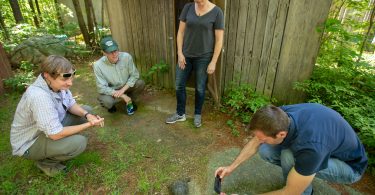Unity College faculty and students partner with Center for Wildlife to re-introduce wood turtle into the wild after years of living in captivity
On a bright and buggy Monday in June, Dr. Matt Chatfield, Unity College Associate Professor of Conservation Biology, along with Trevor Woodhead ‘21 and Greg LeClair ‘18, packed a cat carrier into the back of a minivan, and embarked on a trek from Unity College to Cape Neddick, Maine. Their destination was the Center for Wildlife, and their goal was to reintroduce a rehabilitated wood turtle to its natural habitat.
Given that the animals who are brought to The Center for Wildlife are intended to be short-term residents before they return to the wild, the staff wouldn’t name an animal like this specific wood turtle. But if they were to, they might call him something like George.
Wood turtles like George are a rare sight in Maine, becoming a species of special concern in the state due to the prevalence of the illegal pet trade and habitat loss, as well as the everyday dangers of being a turtle, like fast-moving cars, trucks, or predators.
So, naturally, when George was brought to the Center for Wildlife missing a front limb, and with significant scarring on his shell, Medical Clinic Director Shelley Spanswick ’03 knew she needed to create a plan that would reintroduce George to the wild where someone could also keep tabs on his progress.
A Unity College alum, Shelley had been following the College’s Wood Turtle project for several years. Beginning in 2015, in partnership with Maine Inland Fisheries and Wildlife and under the guidance of Dr. Chatfield, Unity College undergrads have been marking, recapturing, and studying local wood turtle populations through the use of radio telemetry. The project yields a plethora of useful data to help conserve wood turtles in their habitat, and it also offers students an opportunity to take part in — or even lead — an immersive research project where they can learn new skills pertinent to becoming the next generation of conservation biologists.
“There have been a number of students who have taken part in the Wood Turtle Project over the years, and I think it is a perfect example of what separates Unity College’s style of biology from other schools,” said Unity College President Dr. Melik Peter Khoury. “This project not only gets Unity College students out into the field where they acquire first-hand research experience, it also helps connect them with folks from the Center for Wildlife or DIF&W and other professional organizations. Our students can build a network, which gives them a competitive advantage and a sense of how to work in a professional setting.”
When it came to reintroducing George to the wild, she saw a perfect fit for both the College and the Center for Wildlife.
Over the winter, Shelley and the team at the Center for Wildlife monitored George to make sure that he was fit for release, and by May, he was clearly ready to go. Shelley reached out to Dr. Chatfield and DIF&W Wildlife Biologist Derek Yorks to collaborate on a plan to tag George and release him safely. The only question was whether George would actually stick around the undisclosed release site long enough to gather any data and monitor him, or if he’d bolt and never be seen or heard from again.
Even with that question lingering in their minds, the crew remained optimistic. “I think it’s wonderful,” said Spanwick. “It’s very rare that we get to track the animals that we release, so being able to have that resource and keep tabs on him and see where he goes, it’s going to provide us a lot of information, especially for turtles who come to the center with similar injuries.”
After touring The Center for Wildlife, which is currently undergoing significant renovations to increase their space, Spanswick introduced the wood turtle crew to George, who impressed the three with his mobility given the injury to his leg. Seeing that he was eager to get back into the wild, they gently wrangled him into the cat carrier and began their journey to the release site.
“The idea is that if this is successful, that we’ll be able to release other turtles and have a feel for what their survival rate is like, how likely they are to stay put, and maybe what sort of behaviors they’re going to exhibit in the wild, relative to other non-rehabbed, non-released, indigenous turtles,” said Dr. Chatfield.
After taking measurements, notching his shell for identification purposes, molding some putty, and attaching a radio, the crew waits at the water’s edge for the putty to finally dry. Then, there’s a consensus. It’s time to release George back into his natural habitat. Trevor leans over the water and gently places George down into the water. There’s little to no movement at first, but then he starts to walk around a bit, and before you know it, he’s swimming. But the question remains: Will he stay?
Weeks go by, and sure enough, George seems to be comfortable with his new surroundings.
“He’s doing well,” said Trevor, who has been monitoring George and has seen that the turtle hasn’t ventured too far from his release site. “Missing a front limb, that’s kind of hard to get around, so that may be why he’s not moving far. But he’s still persisting, and he’s acting like a wood turtle, so that’s good.”
“It’s pretty special, right? Here we have this poor turtle who has clearly been through a lot,” added Dr. Chatfield. “We know some, but by no means all of this turtle’s recent history, only that he’s been in captivity for many months to many years. He’s clearly a fighter. He’s very feisty, he’s able to right himself when flipped over, he moves very well, as we saw he can still swim, so I think his odds are pretty good.”
















